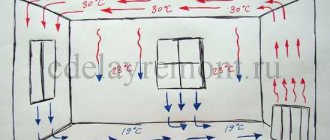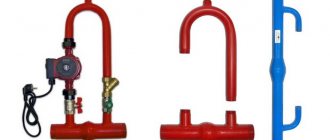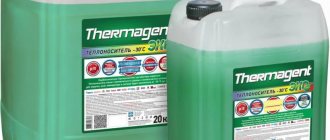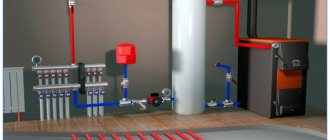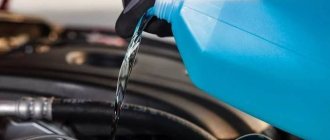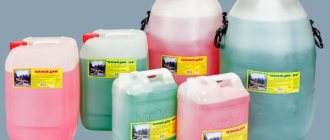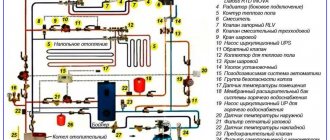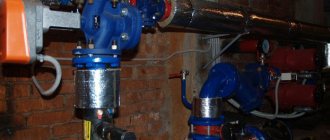Our topic today is quite controversial and is widely discussed on forums. We will talk about the use of antifreeze for heating a house. When we talk about antifreeze, we most likely mean coolant for car radiators. But first of all, antifreeze is a liquid that does not freeze. The same can be said about antifreeze. Is there a difference between them and what is it? Why does everyone keep saying that you can’t pour antifreeze into the circuit, but in practice people still pour it? Or maybe this is another advertising ploy? We will help you figure out whether it is possible to pour antifreeze into the heating system “from A to Z” and untangle this tangle.
Experts do not recommend antifreeze for home heating
Molecule of ethylene glycol - a toxic substance
Let's figure out what is the reason for such a categorical position that it is impossible to pour antifreeze into the heating system of a house. To do this, let's start with the composition of antifreeze. It consists of:
- alcohol base;
- ethylene;
- inhibitors;
- compositions that prevent foaming.
This composition is typical for all foreign-made antifreeze liquids. Only as an active substance in addition to ethylene can there be:
This is the cheapest composition, it has the lowest temperature at which the structure of the additives decomposes. After this, the antifreeze simply destroys the heating circuit, corroding it from the inside. These are all the reasons why it is not recommended to pour antifreeze into the heating system of a house. In principle, the same can be said about ethylene glycol antifreeze, there is no difference. That is, experts are against the use of compounds with ethylene, and antifreeze is one of these.
It is designed for cars, so it is produced only with poisonous ethylene, because where it is used, this does not matter. Non-toxic propylene glycol and glycerin antifreezes are produced abroad.
Ethylene glycol, which is part of antifreeze, can cause chemical burns
Forewarned is forearmed. Knowing that antifreeze is poisonous, you can take measures to prevent it from causing harm. The use of antifreeze in the heating system must be carried out in such a way that the composition does not have access to the room where people are located. Therefore, it is better if antifreeze is poured into a sealed heating circuit. If you need it to circulate along an open circuit, then you need to modify the design of the expansion tank. The expanzomat must be hermetically sealed with a lid, and there must be a hole in the lid. A tube is inserted into it and leads outside. That's all, ethylene glycol vapors are no longer scary.
The only thing that is really dangerous about heating a private home with antifreeze is the possibility of a leak. There is no way to insure against this. In addition, due to the fact that antifreeze has a lower surface tension than water, it has greater fluidity. This means that it finds even the smallest cracks and leaks out. Moreover, if a leak appears, it will in no way disappear on its own, as is the case with water. It will leak constantly until the pipes and joints are repaired.
It is not always possible to detect a leak in a heating system immediately. It turns out that for some time everyone who is in the house, without knowing it, breathes ethylene glycol vapor. In general, such a composition is not used for permanent housing, but heating in a garage using antifreeze is another matter.
Most importantly, you cannot pour antifreeze into systems where there is a double-circuit boiler. If something goes wrong and part of the coolant gets into the DHW circuit, the consequences can be very serious.
Results
Antifreeze is the same ethylene glycol antifreeze. Antifreeze can be used in a heating system if you are careful. In permanent residences, it is better to abandon this idea; there are too many pitfalls. Do not forget that antifreeze is very toxic. Therefore, under no circumstances should it be used in systems with a double-circuit boiler. You should also remember the operating rules (do not overheat, do not breathe in vapors, do not take orally, change on time). Undoubtedly, by pouring antifreeze into the circuit, you will save twice as much as compared to non-toxic foreign propylene glycol compounds. But are these pennies worth the risk? The question is rhetorical.
Is it possible to dilute antifreeze with water?
Car enthusiasts are often faced with a situation where they need to add antifreeze to the cooling system, but they don’t have the necessary liquid on hand, and the nearest store is not close. The first thought that comes to mind is to add regular water. But before you do this, you need to know whether it is suitable for these purposes.
When and why to dilute
Since antifreeze contains a significant portion of water, nothing bad will happen when it is added. In this case, the concentration of antifreeze will simply decrease and the more water you add, the worse its properties will be. However, there are situations when it is recommended to dilute the coolant. This has to be done, as a rule, if the antifreeze has been subjected to boiling, during which part of the water has evaporated and the liquid in the cooling system has become more concentrated.
Mixing in summer and winter
Basically, water has to be added to antifreeze in the summer, since the liquid evaporates more actively. Add water in accordance with the following recommendations:
- if initially the engine cooling system was filled with a concentrate that had not previously been diluted, and about 100–250 ml of antifreeze was used, then you can safely add distilled water to it;
- If there is significant evaporation of antifreeze, it is better to bring the level to normal using the original composition. If the brand of liquid filled is unknown, then distillate should be used for dilution, and the antifreeze should be replaced in the fall.
If the antifreeze has evaporated in large quantities, then it is better to bring it up to normal with the original composition.
In winter, adding water in any quantity is prohibited. Otherwise, there is a high probability of problems with the cooling system or engine as a result of freezing, which will lead to expensive repairs.
What kind of water is suitable
The ideal option for diluting antifreeze is distillate. It does not contain calcium and magnesium. It is not worth using ordinary water for the purposes under consideration, since it negatively affects the components of the cooling system. If you use such water to dilute antifreeze, it may precipitate. Tap water can be filled only if the hardness level is low - no more than 5 mEq/l. If it is not possible to determine the hardness, then water and antifreeze should be mixed in small quantities and if there is no sediment, it can be added to the system.
It is best to use distilled water to add to antifreeze.
Manufacturer's recommendations
If you follow the recommendations of antifreeze manufacturers, they prohibit adding water to the product in question. This is explained by the fact that antifreeze initially contains various additives that extend the life of the cooling system, lubricating the necessary components and providing better engine cooling. Water will only worsen these indicators. While domestic cars used to use water without any concerns, the cooling system of modern cars is made of aluminum alloys, which are susceptible to corrosion from water with a high hardness index. As a result, the radiator becomes clogged over time, which will lead to constant overheating of the engine.
Solid fuel boiler
The fuel used in this installation is firewood, coal, coke, and peat briquettes. Heating using a solid fuel boiler (Fig. 4) is autonomous heating for a summer house. The advantage of this equipment is the low cost and distribution of fuel. This is a way out of a situation when the village has problems with electricity and there is no gas supply.
Rice. 4 Installation of a solid fuel unit at the dacha
New models of solid fuel autonomous boilers have many advantages. They work with any coolant (antifreeze, water) and maintain the temperature in the house for a long time thanks to a special valve and sensor. This boiler has more time between fuel loads. Heating a dacha with wood is a cheap and effective option.
Water or antifreeze - comparison of parameters
Water is a common natural element, widely used as a heat carrier, but due to its too high freezing point, it has to be replaced in domestic heating with glycol antifreeze, which have the following indicators in comparison with water:
- Their specific thermal capacity is 15% lower than that of water, which means that with the same volume, glycol accumulates 15% less energy when heated and, accordingly, releases less. Consequently, to transport the same amount of heat as water per unit time, its speed of movement through the pipeline must be greater by the same amount.
- The density of antifreeze is slightly higher (by 5 - 10%) than water, and the viscosity is 30 - 50% higher than water indicators - this means that when the liquid moves through the pipeline, the hydraulic resistance increases. Compared with water coolant, the circulation pump will require more power and, accordingly, electricity consumption to move the same volume of antifreeze as water.
- Their thermal expansion coefficient is 30 - 40% greater than water; when heated, the glycol coolant increases in volume by 5%, the expansion is insignificant, but sometimes a slightly larger hydraulic tank may be needed.
- Due to their low surface tension, they are 50% more fluid than water - this places increased demands on sealing. Conventional rubber gaskets will have to be replaced with paronite gaskets; it often happens that the internal gaskets of heating radiators are not designed to work with glycols and measures will have to be taken to eliminate leaks between sections (modern radiators usually do not have such problems).
Rice. 2 Properties of antifreeze compared to water
- A significant drawback of relatively cheap antifreezes based on ethylene glycol is a high danger to human health; the substance is poisonous with a lethal concentration of 2 mg. per 1 kg. weight. Therefore, ethylene glycol is prohibited from being poured into systems with an open storage tank in the attic; the circuit must be closed.
- They have a short service life, designed for 10 seasons and amounting to no more than 5 years, this is due to the decomposition of anti-corrosion additives during operation. After this, you will have to drain the antifreeze from the system, dispose of it (with poisonous ethylene glycol this is a definite problem) and pour new coolant into the circuit - this will entail unjustified financial expenses.
- Unlike neutral water, low-quality or expired glycols decompose over a certain period, forming solid sediment that clogs fittings and destroys pipeline fittings.
- Another significant drawback of non-freezing coolants is the relatively high cost: a 20-liter canister of ethylene glycol with crystallization at -30º C will cost 15 USD, the price of the same volume of propylene glycol will be 30 USD.
- It should also be noted that during operation, antifreezes are very sensitive to critical temperatures - when overheated, the glycols and additives included in their composition decompose with the formation of solid insoluble precipitates and acids. This leads to the appearance of carbon deposits on the heating elements of the boiler that come into contact with the coolant; the metals are subject to destructive corrosion, and the sealing elements also suffer. The process is accompanied by increased foaming, leading to airing of the system and disruption of its functioning.
- They have restrictions in their use; their use in electrolysis boilers and pipelines made of galvanized steel is prohibited - the metal is subject to increased corrosion with the formation of an insoluble precipitate of white flakes.
Rice. 3 Features of glycol-based coolants and their cost
- A significant disadvantage of using antifreeze is the refusal of many heating boiler manufacturers to provide warranty service if glycols are poured into the system.
- The only and main advantage of antifreeze in comparison with water is the low freezing point, reaching up to -70º C. Even when a higher-temperature composition freezes (it is obtained after dilution with water in a certain concentration), the substance turns into a jelly-like mass with minimal expansion. Therefore, if you pour antifreeze into the heating system, the integrity of the pipes and boiler is guaranteed at any natural negative freezing temperatures of the circuit.
Rice. 4 Antifreeze in the heating system of a private house - instructions
A gas boiler
Today, the most comfortable way to heat a dacha in winter is autonomous heating with a gas boiler (Fig. 5). But the main problem is that not all dacha cooperatives have a central gas pipeline. Then you can use liquefied gas. For gas boilers, the ideal option is to install a water system.
For an autonomous system with a gas appliance, you will need the following elements:
- boiler;
- heating radiators;
- gas pipeline;
- shut-off valves and automation;
- Coolant in the form of antifreeze.
In the case of heating a dacha with liquefied gas, you need cylinders or a gas holder (a liquefied gas installation that is buried in the ground) connected to the system by a gas pipeline. Heating with liquefied gas is autonomous.
Rice. 5 Gas wall unit
As for the gas boiler, it is better to entrust this installation to qualified gas workers who will install heating in the dacha on a turnkey basis. For a summer residence, it is better to choose a gas boiler that is resistant to pressure changes; such models are produced by domestic manufacturers.
Antifreeze production technology
Shampoos, glass cleaners and coolants are produced on the same equipment. This is due to the fact that their production is identical. It consists of mixing all components in certain quantities. Therefore, along with antifreeze, other automotive chemicals can be produced.
Antifreeze production technology consists of the following stages:
- Preparation of concentrate from glycols and additives.
- Purification of the resulting mixture.
- Diluting the solution with demineralized water.
All ingredients are taken in the quantities required by the technology. Otherwise, the finished product will be unusable. After all stages have been completed, the resulting material is sent for sampling, where it is tested before sale.
Liquid that meets all requirements and standards is bottled in plastic bottles. If an organization carries out wholesale sales, then antifreeze can be placed in barrels containing compressed nitrogen.
Staff
The number of employees depends on the volume of production, area and financial capabilities of the owner. This could be three people or more. It is advisable to select candidates for work in the workshop who have a technical education. They will be able to understand the technology for producing antifreeze fluid for cars.
If a worker without experience and qualifications does not understand the technological process and follow GOST instructions, the finished product will be of poor quality. Therefore, it will not pass the test and will not be suitable for sale.
Separately, you will need to hire personnel who will pour the finished material into containers. But with a large production volume, it is better to buy a specialized line that bottles liquids (up to 2000 liters per hour) into bottles up to 10 liters.
Safety of use
If we are talking about safety, then the coolant should not exceed the standards for toxicity and ignition temperature; the same requirements also apply to liquid vapor. An important factor when choosing is cost. The price must be relatively low, otherwise the consumer must be able to use the coolant for a long time without replacing it.
How to distinguish antifreeze from antifreeze
How to distinguish antifreeze from antifreeze
In order to continue this topic, it is necessary to take a deeper look at these two liquids and what they are. Initially, antifreeze is divided into two types: mineral and organic. The first is used for old, domestic cars, the engines of which were made of cast iron. This type is antifreeze. In fact, antifreeze is antifreeze due to its identical purpose. But there are still differences. The difference between antifreeze and antifreeze is primarily the freezing temperature. Antifreeze freezes at lower temperatures, which is why it is used in areas where the thermometer may show 20 degrees below zero.
With the advent of engines made of light alloy materials, additives that cause corrosion were removed from antifreeze, and since then it has become an organic antifreeze. Antifreeze and antifreeze consist of alcohol, distilled water and additives that have different purposes. Starting from sealing the holes in the cooling system pipes from the inside, to cleaning the system. But all the consequences of the “work” of these additives remain within the system, so their usefulness can still be debated for a very long time. Also, these additives are different in both antifreeze and antifreeze. How to determine antifreeze or antifreeze? And it's very simple. Antifreeze tastes sweet. But there is one thing! This liquid is very poisonous and tasting it is strictly prohibited! Do not rely on the color of the liquid to tell you about its quality. The purpose of using the dye is certainly not to lower the freezing point, or increase the boiling and evaporation temperature, but it serves to make it easier to check the coolant level in the expansion tank.
Based on this, if you have a question about whether it is possible to mix antifreeze and green antifreeze or whether it is possible to mix antifreeze and red antifreeze, know that the color does not matter. What matters is the package of additives that are found in one or another type of liquid.
How to do this correctly?
First, you should remove the old antifreeze from the tank - it is located in the radiator and also in the cylinder block. When carrying out work, the car should be placed on a hill - this way much more of the cooling mixture will drain out. The system should be flushed with distilled water; It’s also worth adding special. means for carrying out work.
Antifreeze should not be poured into the car to the brim, the lid should be open, then the car engine is turned on again and the air is released into the space. Afterwards the neck should be screwed on. Prepare and place a container under the cooling drain points in advance. mixtures in cars. Next, you should unscrew the drain valve on the cooling system. You need to open it as carefully as possible, and do this while pouring antifreeze. Perform the draining itself slowly. After you have drained the main part of the coolant
mixture, unscrew the lid. It is also worth paying attention to the fact that the pipe systems and tap can be located at different points, since much depends on the design solutions of the car. After draining the car's coolant, you should seal the cooling system by turning off the pipes and the valve. After that you can start filling in a new portion of antifreeze. To prevent the mixture from spilling, it is worth placing the watering can in a special expansion tank or insert it into the radiator
It is usually located under the hood; Next, take a container and fill it with antifreeze. This should be done gradually, while trying not to pour all of your antifreeze into the tank in one fell swoop. It is worth remembering that if the pressure is too high, a water plug may appear. It is also worth noting that the extension. The tank usually has a maximum fill mark and a minimum fill mark. That is why it is recommended to pour no more cooling mixture than the set level. When pouring antifreeze or antifreeze, it is worth screwing the cap of the expansion tank tighter.
This is essentially almost all actions. Now you understand how to properly fill in antifreeze (you can understand in more detail in the video below). After all these procedures, it is better to play it safe and start your car, allowing it to reach the required temperature.
Also check how the car's cooling system works and what condition it is in. Check the antifreeze level in it.
Diesel boiler
Diesel units are autonomous equipment that runs on diesel fuel - diesel fuel. This boiler requires electricity to operate. The diesel boiler is equipped with a fan burner, which functions so that when fuel is atomized, it mixes with air and combustion becomes more intense.
Diesel boilers from modern manufacturers have a removable burner design and the equipment can be converted to gas. To do this, install a gas burner. For a dacha, this is quite convenient, since if a gas main appears in the village, you can easily redo the system. A diesel autonomous boiler operates with a water system, during the installation of which it is better to rely on a coolant in the form of antifreeze.
But the disadvantages of this equipment include the high cost of fuel. Considering the option of heating a dacha, we can conclude that the boiler will not burn constantly, and accordingly the costs will be small. If necessary, its installation is carried out by specialists on a turnkey basis.
If you are planning to equip your dacha not only as a place for a seasonal stay, but also for living in the winter, one fireplace as a heating source is not enough. But how to choose heating for a country house so that it is as efficient as possible and at the same time affordable? Next, we will try to answer this question and consider possible options for heating a country house.
For year-round living in a country house, a high-quality heating system is necessary.
Volume calculation and filling
To avoid emergency situations, liquid must be poured into the heating system strictly in a certain volume. It is calculated taking into account the following factors:
- type of heating system;
- its material;
- internal volume of the boiler;
- the area of the room that is planned to be heated.
It is recommended to carry out calculations according to the instructions for the equipment, and also take into account whether antifreeze can be used in it at all. But there are situations when the technical documentation does not contain any information on this matter, then the calculation is carried out by studying the relevant literature. And in some cases, you will need the help of a specialist who will help you carry out all the calculations and put the system into operation.
After filling, do not forget to test the equipment
You also need to know how to properly fill the coolant into the system. If there is already old media in it, then it will need to be drained. It is also necessary to check the degree of contamination; the system may need to be cleaned first, otherwise mixing two anti-freeze agents will cause an unexpected chemical reaction.
We suggest you familiarize yourself with How to weave the bottom of a basket from newspaper tubes
In a closed system, the filling point should be located below other heating devices. Antifreeze is poured using pumping equipment, but the pressure in the pipes must be no higher than 3 atmospheres. And if it is open, then filling must be done through the upper expansion tank.
Electric boiler
An electric boiler is a device that only needs electricity to heat a house. Both water and antifreeze can act as a coolant. But for country heating, antifreeze is better suited. The water system is heated using heating elements. Care must be taken to ensure that there is no leakage of antifreeze, as the device may burn out.
Specialists install such a boiler on a turnkey basis, and a two-tariff meter is also installed, since electricity tariffs at night are significantly lower than during the day. Often such an autonomous installation is used in winter as additional heating equipment, turning it on at night.
What happens when you mix different colors?
Hands down, nothing will happen if you mix formulations from different manufacturers, although there are certain conditions. Situations can be different, including force majeure, so read the ingredients first. If green G11 is mixed with green, but from a different manufacturer, with the most similar parameters, the engine will not be damaged. This also applies to other standards. Only coolant products of the same color and additives can be mixed with each other.
Now about the “traffic light”. As mentioned above, the same G11/12/13 can have a wide palette of shades. Antifreeze of different colors with an identical formula will interact perfectly with each other. The main headache for motorists is the G13 in purple and yellow. Many are afraid that they are completely different, although this is fundamentally false. Let's start with the fact that this antifreeze is universal in nature and has a double portion of additives that get along with each other without any special consequences. You will just get a new shade, nothing more.
How to determine what is flooded?
It will not be possible to check and recognize using color what is in the car. Antifreeze is always colored blue. But modern antifreezes are also available in blue.
If you don’t know what’s in the car, you can determine the type of consumables based on several factors:
- Smell and taste. Antifreezes are usually odorless, and if you touch the liquid, it will be more oily, unlike traditional antifreeze.
- Determining the type of liquid can be done by diagnosing the compatibility of the refrigerant with ordinary water. You need to take a little substance from the expansion tank and mix it with tap water in a 1:1 ratio. Afterwards, the container with the refrigerant is placed in the freezer for about one hour. If, as a result, the liquids separate, the mixed substance becomes cloudy and sediment forms at the bottom, then you use Antifreeze. If high-quality antifreeze is poured into the cooling system of your car, then such problems will not arise.
- Another factor is resistance to negative low temperatures. Pour a small amount of refrigerant into a separate bottle and place it in the freezer. When using Antifreeze, the liquid will quickly freeze, but if a good refrigerant is added, this will not happen.
- Using a hydrometer, you can diagnose the density indicator of a substance. The test should be carried out at an air temperature of 20 degrees. With this condition, the refrigerant density parameter should be about 1.073-1.079 g/cm3. If so, then you are using antifreeze.
For diagnosis, you can resort to the old “old-fashioned” method:
- You will need a plate or other metal device. You will also need a rubber product, for example, a piece of hose from the cooling system.
- Take some fluid from the reservoir under the hood of your car. You need to pour it into a jar or bottle, where you should also place a plate and a piece of hose.
- After 20 minutes, look at the result. Russian-made consumables create a protective layer on all components of the cooling system. Accordingly, you will see a barely noticeable film on both the plate and the piece of hose. If the metal is corroded, and a film has formed only where rust is present, then you use antifreeze. Remove the products from the container and check them by touch.
How can you tell what kind of antifreeze is in your car from the factory?
To understand what brand of refrigerant to add to the refrigeration system, you need to know what is initially added from the factory. You won't be able to determine this on your own. An accurate conclusion can only be given by the results of laboratory tests. Alternatively, you can contact your dealer or read the service manual. It indicates which standard of refrigerant should be used.
You can learn about mixing refrigerants and the results from the video filmed by the Avto-Blogger.ru channel.
Is it possible to fill something in if you don’t know?
If the situation is urgent, for example, while driving you had to stop because the engine overheated, then you can also pour water into the cooling system. If this happens during the cold season, we recommend that you do not ride on water for a long time, but rather drive to the nearest service station or garage to solve the problem. Even when adding fluid in the warm season, after using the car, the cooling system is flushed. In cold weather, water will quickly freeze, and it has the property of expansion, so freezing will damage the expansion tank and pipes.
It is possible to mix only those refrigerants that correspond to each other in composition and standard. Mixing antifreeze and antifreeze is not allowed. This will lead to a chemical reaction, as a result of which the liquid will lose its properties and will not be able to perform its duties. Precipitates form in the cooling system, which prevents the normal circulation of consumables through the lines. Due to the loss of properties, corrosion will appear on the internal parts of the radiator device, which over time will lead to serious damage to the unit.
If you had to mix Antifreeze with antifreeze, then do not delay the replacement process. It is necessary to drain consumables. When changing, the engine is flushed, and the procedure is repeated several times. This is done until clean water without deposits or traces of scale begins to come out of the cooling system. Then we can assume that the cleaning was completed successfully. For washing it is allowed to use special means. When filling, take into account the engine specifications and the manufacturer's recommendations for the use of antifreeze.
For reference
If you are faced with the task of how to fill the heating system in a private house, you must take into account that water in its usual form should not be used, because it is rich in salts and oxygen. Over time, such additives will cause scale to settle on the internal surfaces of the heating system and corrosion will appear. And in order for the system to work without interruption, the liquid must be softened before use.
To do this, you can use one of the existing methods. This may be thermal or chemical technology. In the first case, the technique is based on boiling. The water must be placed in a metal tank in which it must be heated. When boiling, carbon dioxide will be removed, and salts will be deposited at the bottom of the vessel. Stable magnesium and calcium compounds will still remain in the water. The chemical method works using reagents. With the help of soda ash, sodium orthophosphate and slaked lime, the salts become insoluble and precipitate. Subsequent filtration will eliminate any remaining harmful substances.
What does antifreeze contain?
When developing antifreeze, we used the recommendations of Italian developers, and even acquired a license for the production of coolants. But the very first tests showed that the Italian recipe does not work in Russian conditions. Even in the Central region, frosts down to -40...-43 ⁰С are possible, and the imported coolant was designed for -25 ⁰С. Therefore, composition adjustments were required.
The main component is ethylene glycol (C₂H₄(OH)₂). This is a high-boiling alcohol, the share of which in antifreeze can range from 40 to 65%. The second component of the coolant for cars is distilled water.
With regular use of ordinary liquid, the thickness of the scale layer can reach several millimeters. Heat transfer will be disrupted to such an extent that the performance of the cooling system will be extremely low.
When creating antifreeze, we noticed that the mechanical mixture of the main liquids is quite aggressive towards some types of plastics and rubber. C₂H₄(OH)₂ dissolves certain types of plastics and also reacts with sulfur used in the vulcanization process of natural rubber
Therefore, detergent additives were added to the composition. Their number is less than 1%. Practice has proven that even a minimal amount of such substances prevents contact between polymers and alcohols.
Another disadvantage of the usual mixture of water and ethylene glycol is the formation of foam when circulated intensively. Anti-foam additives began to be added to antifreeze in 1979 after motorists had complaints about the operation of the cooling system: foam began to release from the expansion tank of cars operated in the summer. This is the result of the interaction of alcohol (C₂H₄(OH)₂) with aluminum alloys.
Coolant under the brand “Tosol A40M” is produced at several enterprises in Russia and neighboring countries. The composition has not changed for 40 years.
Differences between antifreeze and antifreeze
Today, three types of coolants for internal combustion engines are used: water (distilled or pure rainwater), antifreeze and antifreeze.
Antifreeze is the name of the liquid (translated as “anti-freeze”) for the engine cooling system, which does not freeze and can withstand high temperatures.
Differences:
- antifreeze was invented later than antifreeze;
- Antifreeze is better in terms of environmental friendliness;
- The boiling point of antifreeze is higher;
- The freezing point of antifreeze is lower;
- Antifreeze provides better protection against corrosion.
- Antifreeze forms a protective film, but antifreeze does not, and therefore antifreeze cools much more efficiently.
- The service life for which antifreeze is designed is 6 times less than that of antifreeze.
- antifreeze protects engine cylinder liners from cavitation (air bubbles).
- The service life of the pump (pump) is significantly reduced if antifreeze is used.
- antifreeze does not clog radiators, and various types of deposits do not form.
The main disadvantage of antifreeze is that when heated to 105 degrees, its properties deteriorate.
Antifreeze boils when heated to 115 degrees and does not leave sediment in the channels and can be used for up to 250,000 km.
The confusion about the colors of antifreeze and antifreeze infuriates any motorist. During the 2 years that the cooler is in operation and the driver does not bother replacing it, resilient manufacturers come up with new standards and variations of their products, which only plays into the hands of marketers, but not the consumer.
You also can’t stock up on coolant for future use due to the limited shelf life. Try to choose one manufacturer, find an intelligent seller who will explain in detail what the difference between the compositions is. And you yourself will learn to read the list of ingredients in order to significantly save on the service in the future.
